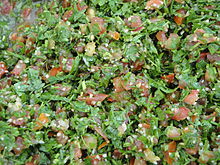| Revision as of 04:53, 17 December 2015 view sourceClueBot NG (talk | contribs)Bots, Pending changes reviewers, Rollbackers6,440,432 editsm Reverting possible vandalism by 2605:E000:3D42:2200:E51F:1F32:A556:2406 to version by 69.165.198.68. Report False Positive? Thanks, ClueBot NG. (2476804) (Bot)← Previous edit | Revision as of 10:34, 4 January 2016 view source 178.135.226.251 (talk)No edit summaryTags: Mobile edit Mobile web editNext edit → | ||
| Line 4: | Line 4: | ||
| | caption = Tabbouleh | | caption = Tabbouleh | ||
| | country = ] | | country = ] | ||
| | region = |
| region = ] | ||
| | course = ] | | course = ] | ||
| | served = Cold | | served = Cold | ||
Revision as of 10:34, 4 January 2016
 Tabbouleh Tabbouleh | |
| Course | Salad |
|---|---|
| Place of origin | Levant |
| Region or state | Lebanon |
| Serving temperature | Cold |
| Main ingredients | Parsley, tomato, bulgur |
| Variations | Pomegranate seeds instead of tomato |
Tabbouleh (Template:Lang-ar tabūlah; also tabouleh or tab(b)ouli) is an Arabian vegetarian dish (sometimes considered a salad) traditionally made of tomatoes, finely chopped parsley, mint, bulgur and onion, and seasoned with olive oil, lemon juice, and salt. Some variations add garlic or lettuce, or use couscous instead of bulgur.
Tabbouleh is traditionally served as part of a mezze in the Arab world. Variations of it are made by Turks and Armenians, and it has become a popular ethnic food in Western cultures.
Etymology
The Levantine Arabic tabbūle is derived from the Arabic word taabil, meaning seasoning. Use of the word in English first appeared in the 1950s.
History
To the Arabs, edible herbs known as qaḍb formed an essential part of their diet in the Middle Ages, and dishes like tabbouleh attest to their continued popularity in Middle Eastern cuisine today. Originally from the mountains of Jordan , Syria and Lebanon, tabbouleh has become one of the most popular salads in the Middle East. In Syria, Lebanon, and Jordan, the wheat variety salamouni cultivated in the region around Mount Lebanon, Beqaa Valley and Baalbek was considered (in the mid-19th century) as particularly well-suited for making bulgur, a basic ingredient of tabbouleh.
Tabbouleh and other vegetable-based mezze dishes popular in Syria were mocked by Baghdadi women and cooks when they were first introduced to them, because they were seen as being a means to scrimp on the use of meat.
Regional variations
In the Middle East, particularly Syria, Lebanon and Jordan it is usually served as part of a meze, with romaine lettuce. The Lebanese use more parsley than bulgur wheat in their dish. A Turkish variation of the dish is known as kısır, while a similar Armenian dish is known as eetch. In Cyprus, where the dish was introduced by the Lebanese, it is known as tambouli. In the Dominican Republic, a local version introduced by Lebanese immigrants is called Tipile.
Like hummus, baba ghanouj, pita and other elements of Arab cuisine, tabbouleh has become a popular "American ethnic food".
See also
References
- Sami Zubaida, "National, Communal and Global Dimensions in Middle Eastern Food Cultures" in Sami Zubaida and Richard Tapper, A Taste of Thyme: Culinary Cultures of the Middle East, London and New York, 1994 and 2000, ISBN 1-86064-603-4, p. 35, 37; Claudia Roden, A Book of Middle Eastern Food, p. 86; Anissa Helou, Oxford Companion to Food, s.v. Lebanon and Syria; Maan Z. Madina, Arabic-English Dictionary of the Modern Literary Language, 1973, s.v. تبل
- Oxford Companion to Food, s.v. tabbouleh
- ^ Mark Morton (2004). Cupboard Love: A Dictionary of Culinary Curiosities (2nd ed.). Insomniac Press. p. 302. ISBN 978-1-894663-66-3.
- "Tabouli: Syrian Levantine Parsley and Bulgur Salad". Arousing Appetites. Arousing Appetites.
- Wright, 2001, p. xxi.
- Madison Books, ed. (2007). 1,001 Foods to Die For. Andrews McMeel Publishing. p. 172. ISBN 978-0-7407-7043-2.
- ^ Basan, 2007, p. 180-181.
- Nabhan, 2008, pp. 77-78.
- Caplan, 1997, p. 73.
- ^ Wright, 2001, p. 251. "In the Arab world, tabbouleh (tabbūla) is a salad usually made as part of the mazza table (p xx) especially in Syria, Lebanon and Palestine."
- Arthur L. Meyer, Jon M. Vann, The Appetizer Atlas: A World of Small Bites, John Wiley and Sons, 2003, p. 353.
- Terry Carter, et al., Syria and Lebanon, Lonely Planet, 2004
- https://books.google.ca/books?id=bB2cedC3ruQC&pg=PA56
- Zalinksy, 2001 p. 118.
Bibliography
- Basan, Ghillie (2007). The Middle Eastern Kitchen. Hippocrene Books. ISBN 978-0-7818-1190-3.
- Caplan, Patricia (1997). Food, health, and identity (Illustrated ed.). Routledge. ISBN 978-0-415-15680-6.
- Nabhan, Gary Paul (2008). Where our food comes from: retracing Nikolay Vavilov's quest to end famine (Illustrated ed.). Island Press. ISBN 978-1-59726-399-3.
- Wright, Clifford A. (2001). Mediterranean vegetables: a cook's ABC of vegetables and their preparation in Spain, France, Italy, Greece, Turkey, the Middle East, and north Africa with more than 200 authentic recipes for the home cook (Illustrated ed.). Harvard Common Press. ISBN 978-1-55832-196-0.
- Zelinsky, Wilbur (2001). The enigma of ethnicity: another American dilemma (Illustrated ed.). University of Iowa Press. ISBN 978-0-87745-750-3.